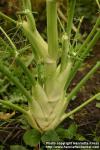2.21 Fennel
 Latin name: Foeniculum vulgare.
Latin name: Foeniculum vulgare.
2.21.1 Growing fennel
From: Sonny Hays-Eberts <eberts.oregon.uoregon.edu>:
Fennel is easy to grow, growing wild in many areas. An annual, it looks like dill, only slightly more coarse. I've had problems in wet years with it getting some sort of mold, but is generally quite troublefree. It prefers full sun and well-drained soil. Seeds can be planted as soon as frost danger is past. It's best to blanch (cover with dirt) the bulbs if you plan on harvesting them to keep them tender. Plants should be thinned to about a foot apart. You should get some volunteers if you let them go to seed.
2.21.2 Harvesting fennel
From: Sonny Hays-Eberts <eberts.oregon.uoregon.edu>:
The tender leaves may be diced and used to add a hint of licorice flavor and is great to use with seafood. Fennel seed can be used with poppy seed, sesame seed, celery or dill seed on bread. The bulb of the plant is also commonly harvested, though I always let mine go to seed instead. For best flavor harvest the leaves just as the flowers are starting to bloom.
> Can anyone give me some ideas on how to store or prepare the surplus of fennel seeds in my yard?
From: HerbalMuse.aol.com
If you intend to use the seeds in baking or other cooking, then you must collect them from the flower heads as soon as they begin to turn brown, or they will fall to the ground to re-seed. I store whole dill seed heads (as you can do with fennel) in paper bags and keep them in a cool, dry pantry in the basement. Fennel seeds are excellent with grilled or broiled fish, chicken, with tomato based soups, and of course, in breads, cakes & cookies.
If the seeds have already fallen to the ground, and are not cleared away, you can expect to see the emergence of new plants in early spring. This may delight you, however you should consider where these plants will grow in relation to the rest of garden. Fennel should be grown in a bed of it's own since most herbs won't do well in its presence, and it will stunt tomatoes and bush beans.
2.21.3 Using / preserving fennel
From: Sonny Hays-Eberts <eberts.oregon.uoregon.edu>:
The leaves and seeds may be dried. The leaves may also be frozen. The tastiest way I've had it is from a local restaurant, Ambrosia. A dish called fettucine Gamberi, it had fettucine (duh!) in a parmesan cream sauce with garlic, fennel leaves, parsley, scallops, shrimp, capers and fresh tomatoes. Quite tasty! Fennel has an anise or licorice flavor, and can be used to flavor cheeses, vegetables and some pastries in addition to seafood.
From Karen White
Fennel seeds - This is often used in making sausage, so I use it when cooking to give things a "sausage-y" flavor without actually using sausage. Works great when using tofu instead of meat, or when using ground beef instead of sausage. I always use it when making spaghetti.
If you crush the seeds a little just before using them, the flavor is a lot better.
2.21.4 Which Fennel do you have?
From: Sonny Hays-Eberts <eberts.oregon.uoregon.edu>:
There are two common types of fennel; Bronze Fennel and Common Fennel also known as Finocchio (or Florence Fennel). True to it's name, the Bronze Fennel's foliage is a dusky brown. My experience has all been with bronze fennel, which is pretty in the garden as well as useful for cooking.

